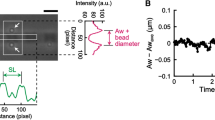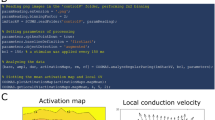Abstract
WHEN the heart stops beating, pulsations in individual cardiac muscle fibres continue. This can be observed by examining thin sections of living cardiac muscle under high-power magnification and transmitted light. The pulsations appear to be due to alternate relaxations and contractions of the fibres, with a concomitant change in the width of the striations. Under low-power magnification and by reflected light, the activity seen in the isolated mammalian heart is that of spontaneous minute contraction waves. Prinzmetal et al.1 have noticed a similar though much faster activity in human and dog fibrillating auricles. It disappeared with the cessation of fibrillation.
This is a preview of subscription content, access via your institution
Access options
Subscribe to this journal
Receive 51 print issues and online access
$199.00 per year
only $3.90 per issue
Buy this article
- Purchase on Springer Link
- Instant access to full article PDF
Prices may be subject to local taxes which are calculated during checkout
Similar content being viewed by others
References
Prinzmetal, M., Corday, E., Brill, I. C., Oblath, R. W., and Kruger, H. E., “The Auricular Arrhythmias” (C. C. Thomas, Springfield, Ill.; Blackwell, Oxford, 1953).
Langley, J. N., J. Physiol., 51, 377 (1917).
Hellmann, K., J. Physiol., 120, 41P (1953).
Author information
Authors and Affiliations
Rights and permissions
About this article
Cite this article
HELLMANN, K. Spontaneous Microscopic Activity in Cardiac Muscle. Nature 175, 212–213 (1955). https://doi.org/10.1038/175212b0
Issue Date:
DOI: https://doi.org/10.1038/175212b0
This article is cited by
-
Die Wirkung von Coffein und Theophyllin auf den Herzmuskel
Archiv für Kreislaufforschung (1955)
Comments
By submitting a comment you agree to abide by our Terms and Community Guidelines. If you find something abusive or that does not comply with our terms or guidelines please flag it as inappropriate.



